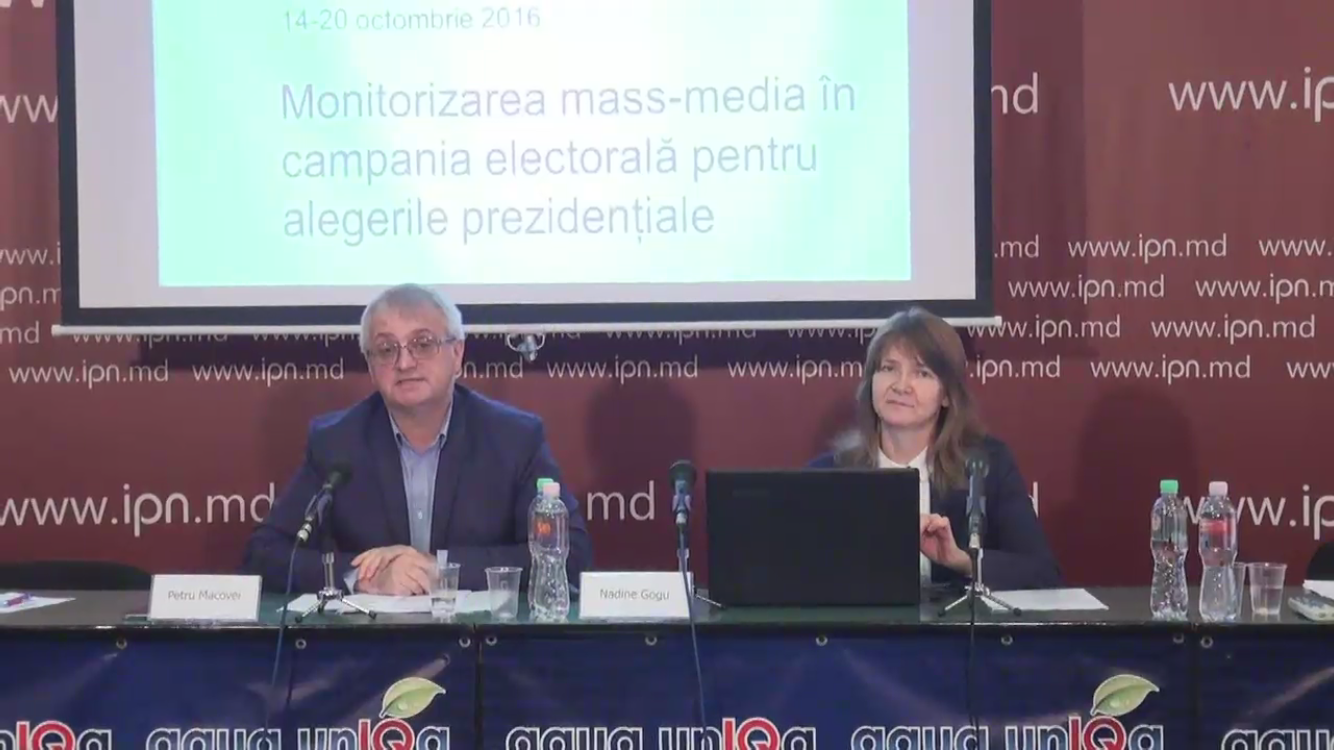
According to the report, in the monitoring period of October 14-20, 2016, televisions maintained the tendency of favoring or disfavoring the same candidates. Prime, Canal 2, Canal 3, Publika TV continued promoting Marian Lupu, candidate of the Democratic Party of Moldova, and disfavoring Maia Sandu, Dumitru Ciubasenco and Andrei Nastase. Jurnal TV favored Andrei Nastase and Maia Sandu, while Marian Lupu was in the majority of cases disfavored. NTV Moldova and Accent TV favored Igor Dodon, candidate of the Party of Socialists, and disfavored Maia Sandu.
Only public broadcaster Moldova 1 and private channels Realitatea TV, Pro TV Chisinau and TV 7 had a relatively balanced behavior, without showing tendencies of clear favoring or disfavoring of candidates.
At the same time, Nadine Gogu, Executive Director of the IJC, pointed out that in the reporting period four broadcasters (Prime, Canal 2, Canal 3, Publika TV) organized election debates that they aired at 6 o’clock in the morning. “We believe it is an attempt to simulate correct and neutral coverage, since in the declaration that they submitted to the BCC [Broadcasting Coordinating Council] regarding coverage of the election campaign they mentioned that they would have election debates. And now, when they submit reports, they will indicate that those debates actually took place,” she said.
On the monitored web portals, Maia Sandu was the candidate with the most visibility. She was referred to or cited 112 times, and the context of such appearances was favoring (75 times) more often than disfavoring (37 times). Marian Lupu was much more often presented in negative context (89 cases) than in favoring situations (20 cases), as well as Igor Dodon (63 articles in negative context and 16 in positive context). Candidates Iurie Leanca and Mihai Ghimpu were disfavored more often than favored.
As for print media, the principle of pluralism of sources was not complied with, and the news reports on a conflict in the election campaign were misbalanced. “KP v Moldove” newspaper continued disfavoring Mihai Ghimpu in commentaries and other opinion articles. Maia Sandu was alto disfavored. In “Panorama” newspaper, Marian Lupu and Mihai Ghimpu were presented mostly in negative context, being disfavored. “Săptămîna” newspaper published an editorial, in which some candidates were disfavored by means of labels and other offensive innuendos. It also published some articles of hidden advertising in favor of candidate Silvia Radu. “Timpul” newspaper favored candidate Maia Sandu and partially Iurie Leanca, and disfavored Igor Dodon.
To the question of whether the monitoring results for the week of October 14-20 differ from those in previous monitoring periods, Nadine Gogu said: “At the public broadcaster we keep seeing balanced coverage, unlike two weeks ago, when the situation was slightly different. At other channels with national coverage – Prime, Canal 2, Canal 3, Publika TV – we noticed a reduction in appearances by Marian Lupu, candidate of the Democratic Party, and in the number of materials that favored him, but he still remains undeniably leader among the most favored candidates. We don’t exclude the fact that the number of materials decreased also due to the first report launched by the BCC last week, which also noted violations in terms of appearances by party members and candidates in elections.”
In his turn, Petru Macovei, Director of the AIP, mentioned: “Although some colleagues had critical reactions after the presentation of our reports, we notice that the monitored websites, not all of them, but some of the monitored portals especially, changed their editorial policy towards more balanced presentation. However, there still is room for improvement.”
In this reporting period, too, the media published an important number of materials. Thus, televisions in this period aired 801 materials directly or indirectly related to the election campaign, including 719 news reports, 53 shows, 16 election debates and 13 vox populi, amounting to approximately 67.3 hours. News portals published 494 such materials, and the four monitored newspapers published a total of 41 articles on the topic.










